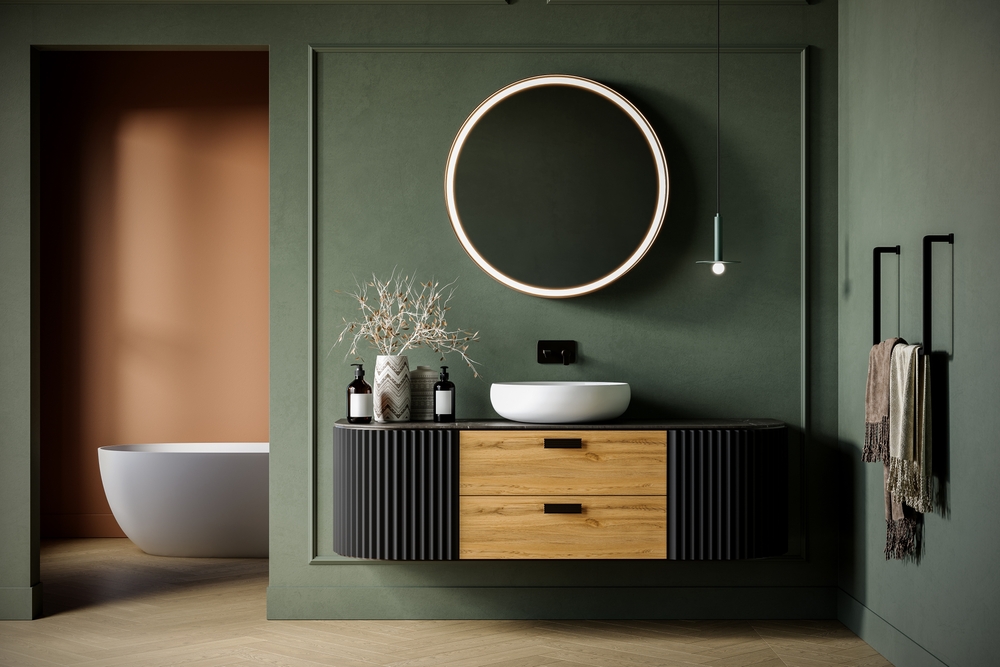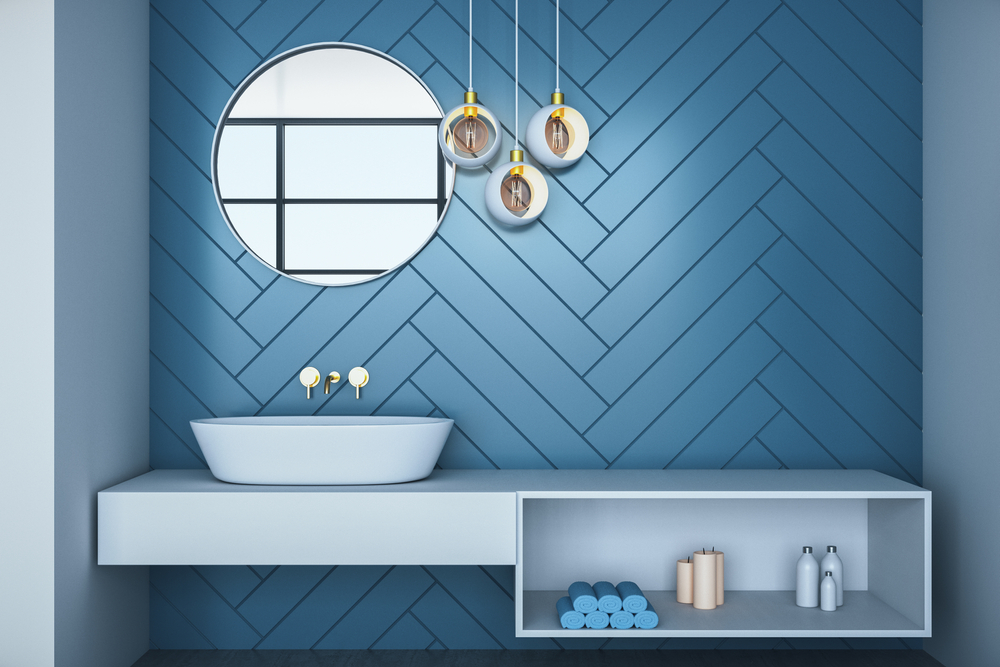What Is Bathroom Vanity?

When you step into a modern bathroom, your attention is often drawn to a central fixture that seamlessly blends form and function: the bathroom vanity. This essential element has evolved significantly from its original purpose, becoming a staple in contemporary home design. But what is bathroom vanity, and why has it become such a crucial component of bathroom design?
We will explore the various aspects of bathroom vanities, including their design options, functionality, and how they contribute to both the aesthetics and practicality of modern bathrooms. We’ll delve into different styles, materials, and features to help you understand how to choose the perfect vanity for your space.
Let’s dive in!
What Is Bathroom Vanity?
A bathroom vanity is an essential feature in any bathroom, combining a sink, countertop, and storage space into a single unit. It serves as the central point for everyday activities like washing hands and brushing teeth. Vanities come in various styles and sizes, ranging from compact designs for smaller spaces to larger models with double sinks for busy bathrooms.
When selecting a vanity, consider the size of your bathroom, your storage requirements, and your personal style. This will help ensure that the vanity not only meets your functional needs but also complements the overall design of your bathroom. A well-chosen vanity can enhance the look of your space while keeping it organized.
Components of a Bathroom Vanity
A bathroom vanity consists of several key components that blend function and style. The sink, available in styles like drop-in or under-mount, is central for daily use and is made of materials such as porcelain or stainless steel.
The countertop, made from granite, quartz, or laminate, sets the bathroom’s aesthetic and provides space for toiletries. Storage options beneath the sink include cabinets or drawers for organizing essentials, while a mirror above the sink aids in grooming tasks.
Moreover, the faucet, both practical and stylish, completes the vanity. These elements create a functional and attractive fixture that enhances your bathroom’s look and usability.
Types of Bathroom Vanities
Bathroom vanities come in various styles to suit different spaces and needs. Here are the main types and their ideal use cases:
Freestanding vanities
Freestanding vanities are the most common type. They sit directly on the floor and offer stability, working well in most bathroom layouts.
They’re ideal for larger bathrooms with ample space and often provide more storage options. Freestanding vanities are perfect for families needing extra space for toiletries and linens.

Wall-mounted vanities
Wall-mounted vanities attach directly to the wall. They create a floating effect that can make a bathroom feel more spacious. These vanities are excellent for small bathrooms or powder rooms.
Wall-mounted vanities are easy to clean underneath, making them a hygienic choice. They suit modern and minimalist design aesthetics.
Corner vanities
Corner vanities are designed to fit snugly into bathroom corners. They’re a smart solution for awkward layouts or tiny bathrooms, maximizing space efficiency in small areas.
They’re ideal for guest bathrooms or en-suites where there is little space. These vanities can add a unique design element to your bathroom.
Choosing the right vanity type depends on your bathroom’s size, layout, and your personal needs. So, consider your storage requirements and design preferences when making your selection.
Materials Used in Bathroom Vanities
The material of your bathroom vanity affects its durability, maintenance, and style. We elaborated on the most common options and their characteristics in the following:
Wood vanities
Wood is a classic choice for bathroom vanities. It offers warmth and natural beauty. Hardwoods like oak, maple, and teak are popular options. Also, wood vanities can be painted or stained to match your decor.
Pros
- Timeless aesthetic
- Versatile design options
- Can be refinished
Cons
- Susceptible to moisture damage
- Requires regular maintenance
- Can be expensive

Metal vanities
Metal vanities, often made of stainless steel, add a modern touch. They’re durable and resistant to moisture. Metal vanities suit industrial or contemporary bathrooms.
Pros
- Highly durable
- Easy to clean
- Resistant to water damage
Cons
- Can feel cold or clinical
- Limited design options
- May show fingerprints and water spots
Glass vanities
Glass vanities create a sleek, open feel. They’re often paired with vessel sinks for a striking look. Glass is easy to clean and maintains its appearance over time.
Pros
- Creates the illusion of space
- Easy to clean
- Resistant to water damage
Cons
- Can be fragile
- Shows water spots easily
- Limited storage options
Composite materials
Composite vanities, like MDF or particleboard with laminate, offer affordability. They come in various finishes mimicking wood or stone, making them a budget-friendly option for many homeowners.
When selecting a material, consider your budget, maintenance preferences, and desired aesthetic. Also, consider the humidity levels in your bathroom when making your choice.
Pros
- Affordable
- Wide range of styles
- Relatively lightweight
Cons
- Less durable than solid materials
- Can be damaged by excessive moisture
- May not last as long as other options

Styles and Designs of Bathroom Vanities
Bathroom vanities come in a wide range of styles to suit different tastes and home decor. Below, we included some popular styles and their key features.
Traditional vanities
Traditional vanities exude classic elegance. They often feature ornate details and rich finishes. These vanities suit homes with a timeless, sophisticated aesthetic. Key elements include:
- Raised panel doors
- Decorative moldings
- Antique-style hardware
- Dark wood tones or painted finishes
- Marble or granite countertops
Modern vanities
Modern vanities embrace sleek simplicity, focusing on clean lines and minimalist design. They are ideal for complementing contemporary or minimalist bathrooms. Key characteristics include:
- Flat-panel doors
- Handleless drawers or sleek hardware
- Floating designs
- High-gloss finishes
- Integrated sinks
Rustic vanities
Rustic vanities bring a warm, natural feel to bathrooms. They often incorporate raw materials and textures. These vanities are perfect for farmhouse or cottage-style homes. Their features are:
- Reclaimed wood
- Distressed finishes
- Wrought iron hardware
- Vessel sinks
- Stone countertops

Transitional vanities
Transitional vanities blend traditional and modern elements, offering a balanced, versatile look that suits various home styles and personal tastes.
When choosing a vanity style, consider your overall bathroom design. The right vanity can serve as a focal point or complement existing elements.
Remember, hardware and countertop choices can significantly impact the final look of your vanity. In addition, key aspects include:
- Simple, clean lines with subtle detailing
- Neutral color palettes
- Mix of materials (e.g., wood and metal)
- Undermount sinks
- Quartz or solid surface countertops
Choosing the Right Bathroom Vanity
Selecting the perfect bathroom vanity involves several considerations. Here’s what to keep in mind:
Assess your space
Measure your bathroom carefully. Note the location of doors, windows, and fixtures. Consider traffic flow. A vanity shouldn’t obstruct movement. For small bathrooms, wall-mounted or corner vanities can save space.
Evaluate your storage needs
Think about what you’ll store. Count your toiletries, towels, and bathroom essentials. Choose a vanity with adequate drawers and cabinets. For shared bathrooms, consider double-sink vanities with separate storage areas.
Consider plumbing configuration
Check your existing plumbing layout. Moving pipes can be costly. If possible, choose a vanity that aligns with your current setup. If remodeling, factor in plumbing changes when selecting your vanity location and style.
Match your style
Your vanity should enhance the overall design of your bathroom. Consider the architectural style of your home and your personal preferences when selecting it. Opt for finishes and hardware that harmonize with the other elements in your bathroom.
Think about maintenance
Consider how much time you’re willing to invest in maintenance. Some materials demand more care than others, so opting for easy-to-clean surfaces is ideal for busy households.
Set a budget
Before you start shopping, determine your spending limit. Make sure to factor in costs for installation, countertops, and fixtures. While quality is important, there are options available to suit every budget.
Plan for the future
When considering long-term needs, it’s important to remember that trendy designs can quickly become outdated. Classic styles often have greater staying power and enduring appeal. Additionally, if you plan to age in place, consider accessibility features that will support your comfort and convenience over time.

How to Remodel Bathroom Vanity
Remodeling your bathroom vanity can refresh your entire bathroom’s look. Here’s a brief overview of the process:
Assess and plan
Start by evaluating your current vanity. Identify what you want to change. Consider your budget and timeline. And decide if you’ll DIY or hire a professional.
Choose your approach
You have several options:
- Refinish: Paint or stain the existing vanity for a quick update.
- Refacing: Replace cabinet doors and drawer fronts for a new look.
- Replace: Install a completely new vanity unit.
Key steps
When updating or upgrading your bathroom vanity, whether by replacing it entirely or refinishing it, following these key steps will ensure a smooth and successful transformation.
- Remove the old vanity carefully.
- Check and prepare plumbing connections.
- Install the new vanity base.
- Attach the countertop and sink.
- Connect plumbing fixtures.
- Add finishing touches like hardware and caulk.
- For refinishing or refacing, prep the surface thoroughly before applying new finishes or attaching new components.
Final touches
Once the main work is done, consider updating:
- Mirror
- Lighting fixtures
- Faucets
- Hardware
Remember, each component of a vanity remodel involves its own specific steps. For detailed guides on updating individual elements, be sure to check out our other articles.

Conclusion
So, what is a bathroom vanity? It is a key feature in modern bathroom design, seamlessly combining form and function. It integrates a sink, countertop, and storage into one unit, becoming both a practical fixture and a focal point in the bathroom.
When selecting a vanity, it’s important to consider factors like the size of your bathroom, storage needs, and personal style preferences. Vanities come in various styles, including freestanding, wall-mounted, and corner designs, and are crafted from materials such as wood, glass, and composites.
A well-chosen vanity not only enhances the look of your space but also improves its functionality and organization. So, careful planning and consideration will ensure that your vanity meets both your current and future requirements, contributing to a more efficient and aesthetically pleasing bathroom.
